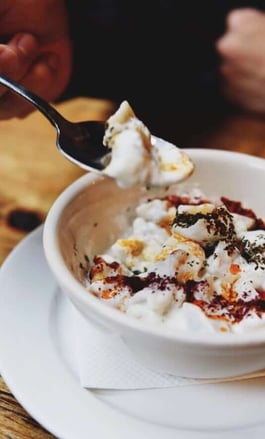Lebne – Yogurt of Turkey
Making, storing and eating strained yogurt is an ancient practice throughout Israel and the Middle Eastern nations. In fact, yogurt has been a staple in the Asian continent for several hundred years now. Despite knowing that yogurt is an extremely old dish in the kitchens of our ancestors, no one is completely sure of the exact origins of the dish. The word itself is of Turkish roots, and the consumption of yogurt spread through most of Western Europe and the Balkan region from Turkey.
Lebne is made by placing yogurt in a fine strainer or cheesecloth for a while so that all the whey runs out. The texture you get is like that of cream cheese, and this is often mistaken to be a curd cheese – though it is actually made from yogurt. The straining process gives you what is commonly called Greek yogurt. Further straining will give you lebne, which has a thicker texture. This is a product that is high in protein as well as calcium. It has a lower level of carbs and sugar when compared to the average yogurt. This makes it a perfect choice for those on diabetic or low carb diets.
Lebne is one of those dishes that comes from a single ingredient. The yogurt you choose to make the lebne with will affect its taste. If you want a more pungent feta-like taste to it, then straining sheep or goat’s milk made yogurt is the way to go. Once you have the base ready, there are several ways in which it may be spiced and seasoned for straight consumption or use in other dishes.
Lebne, across the Arabic world and even in Turkey is eaten as part of a mezze or a platter of dips. The classic way of eating this is as a dip with freshly prepared bread that you break with your hands. To add a bit of classiness to the dip, you can add some pickled gherkins, finely chopped capers or pitted olives. A popular Turkish dip called Haydari uses labneh as its base. It is then mixed with spices, garlic and some herbs. Walk down the market streets of Turkey, and you will find several variations from the classic for sale.
Lebne makes a perfect base for sandwich toppings and salad dressings as well. Split open a pita bread, line it with lebne, and fill it with any vegetable or meat of your choice for a wholesome snack or meal. One version of a dip, calls for mint leaves and chopped green olives. You can eat it by spooning it up with hunks of bread.
There are several serving suggestions for lebne,, and you can come up with your own too. If you strain lebne for a longer time, until it can hold its shape, you can break it up and roll it into small balls, dust them with za’tar spice, chilli flakes and herbs and serve them up as appetizers. You can also marinate the labneh in olive oil and pair it with fried finger food.
Lebne is now also being used, sans seasoning, as a healthier frosting for cakes and desserts. In addition, it is used to create desserts where a milk based ingredient is required to get the right consistency of the batter. It is often used in place of mascarpone too.
As with any other traditional dish that has spread to other parts of the world, there are numerous variations of this dish made from yogurt called lebne, and all you have to do is choose the most appealing.







